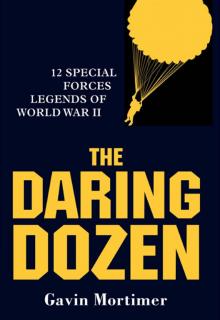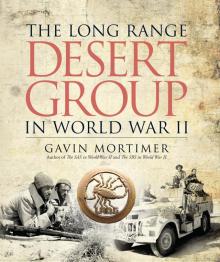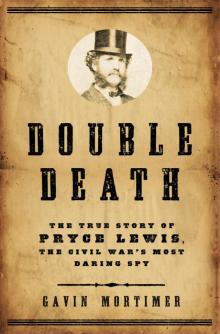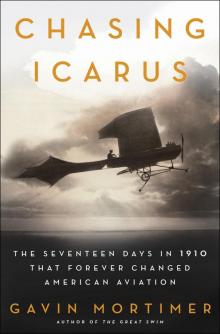- Home
- Gavin Mortimer
Double Death
Double Death Read online
DOUBLE
DEATH
The True Story of Pryce Lewis,
the Civil War’s Most Daring Spy
GAVIN MORTIMER
WALKER & COMPANY
New York
For Margot and Sandy
C O N T E N T S
Author’s Note
Acknowledgments
Prologue “There Goes a Big Slide of Snow”
Chapter 1 “Little Molehills from the Green Sea”
Chapter 2 “A Detective! Me?”
Chapter 3 “Murdered in the Most Shocking Manner”
Chapter 4 “A Plan Had Been Laid for My Assassination”
Chapter 5 “Set a Price on Every Rebel Head and Hang Them”
Chapter 6 “An English Nobleman Travelling for Pleasure”
Chapter 7 “Don’t You Know There Is a War in This Country, Sir?”
Chapter 8 “Grossly Insulting to Some of the Officers”
Chapter 9 “I See You Are a Stranger in These Parts”
Chapter 10 “Do You Mean to Say That You Have Been in Wise’s Camp?”
Chapter 11 “That Is Tim Webster”
Chapter 12 “The Most Persuasive Woman That Was Ever Known in Washington”
Chapter 13 “You’ll Have to Be Mighty Careful Now, or You’ll Be Arrested”
Chapter 14 “It Would Be Folly for Me to Go to Richmond”
Chapter 15 “He Is a Noble Fellow, a Most Valuable Man to Us”
Chapter 16 “I Suspected You All Along”
Chapter 17 “Trust for a Favorable Outcome”
Chapter 18 “We Have All Your Companions”
Chapter 19 “Hanged by the Necks Until We Were Dead”
Chapter 20 “Keep Your Courage Up”
Chapter 21 “I Have Made a Full Statement and Confessed Everything”
Chapter 22 “I Suffer a Double Death”
Chapter 23 “It Was Not War, It Was Murder”
Chapter 24 “They Held Existence by a Frail Tenure”
Chapter 25 “Lewis Remained Staunch, and Did Not Confess”
Epilogue “A Faithful Servant to His Country”
Appendix 1 The Baltimore Plot
Appendix 2 The Trial
Appendix 3 Pinkerton’s Military Espionage
Notes
AUTHOR’S NOTE
PRYCE LEWIS WAS a Welshman, born in Wales to Welsh parents. Yet Britain in the mid-nineteenth century was a country indifferent to racial distinction, and Lewis was happy to call himself an Englishman (by which he meant Briton) regardless of whether he was playing a role in his work as a Civil War spy or discussing his background. Allan Pinkerton also described Lewis as an Englishman, even though he, a Scot, would have been aware of the difference. As Lewis is described in contemporary newspapers and military communiqués as “an Englishman,” I refer to him throughout the book as an Englishman and not a Welshman. This is for the sake of clarity, not because I want to receive sacks of letters from Welsh nationalists accusing me of being a narrow-minded Englishman!
ACKNOWLEDGMENTS
IFIRST CAME ACROSS Pryce Lewis in the summer of 2008 while researching my previous book, Chasing Icarus. As I sat in the New York Public Library scrutinizing the city’s newspapers from 1911, I chanced upon a report describing his wartime career. “Now that,” I thought to myself, “is a great story. I do hope my agent and editor agree.” They did, fortunately, although unsurprisingly. Both George Gibson at Walker Bloomsbury, and Gail Fortune of the Talbot Fortune Agency, have exceedingly good noses when it comes to stories. Jackie Johnson was an assiduous editor with a deft touch for smoothing down rough edges and rooting out superfluity, so I doff my cap in thanks that they all supported, encouraged and guided me so wholeheartedly from the outset, even during the moments when my dark artistic temperament got the better of me.
My research for Double Death began in Sussex, the birthplace of Timothy Webster, and the English county where my parents live. So while I toiled away at the East Sussex Archives in Lewes, I was able to retire at the end of each day to the house of my parents (David and Sheila), where not only was I supplied with good food and fine wine, but my mom even did my laundry! Thanks to them, and to the staff of the East Sussex Archives.
In London I was assisted in my research by the staff of the National Archives in Kew, the British Library in St. Pancras and the National Newspaper Library in Colindale. And Dawn Gill of the Powys Archive in Wales unearthed some crucial information about Pryce Lewis and his family. Not so long ago a visit to any British archive was always a trying experience, mainly because of the antediluvian facilities, but sustained investment in recent years has transformed most British archives into wonderfully user-friendly establishments.
Lastly as far as British thanks go, I owe an immeasurable debt to Mary Oldham and David Pugh of the Newtown Local History Group. David in particular was the personification of patience as I sent him long, rambling e-mails about Pryce Lewis and his early life in Newtown, mid-Wales. Without fail he replied to all my badgering, not just with courtesy but with much invaluable information. David, I am most grateful.
During my research trip on the other side of the Atlantic I—as always—walked into a barrage of kindness. The staff at the Library of Congress and the National Archives in Washington, D.C., assisted me in every way possible, as did the employees of the New York Public Library. My epic voyage north from New York City to St. Lawrence University in Canton, New York, close to the Canadian border, involved a lot of snow, a lot of Amish (that’s a story for another day) and many long hours in a bus. But my reward was the incredible Pryce Lewis Collection and a few days on the beautiful campus of St. Lawrence. Everyone was unfailingly generous in their hospitality but none more so than Mark McMurray, the archivist, Darlene Leonard, his assistant, and Tish Munt, one of the librarians. Thank you so much.
Other people went out of their way to help me in researching and writing Double Death. Patty Goff was good enough to send me complimentary copies of her books, Allan Pinkerton and the Larch Farm and Timothy Webster: The Story of the Civil War Spy and His Family. As usual, Tom Schoff opened the door of his Manhattan B&B and made sure there was always a good bottle of red close at hand, which was usually finished as we put the world to rights. Zoe Lucas and Lyall Campbell of Halifax, Nova Scotia, answered some questions I had regarding emigration routes between Britain and Canada; similarly Claudia Cheely and Kevin Nelson of the Western Virginia Planning Department furnished me with some information about Hanover County in the Civil War. The astonishingly knowledgeable Bob Krick of the National Park Service, Richmond National Battlefield Park, fielded some important questions. Leo Lawton did likewise on the subject of Hattie Lawton.
But the people I have most to thank have been dead for decades.
On November 15, 1888, David Cronin, in his introduction to Pryce Lewis: His Adventures as a Union Spy During the War of the Rebellion, wrote, “The narrative of Pryce Lewis is published chiefly because it is believed that it will be found interesting to the general reader as well as to students of our late Civil War.”
Alas, despite the best efforts of Cronin, himself a veteran of the Civil War and the editor of Lewis’s memoirs, no publisher was found. In the early years of the twentieth century Cronin and Lewis tried once more to get the manuscript published but again without success. In due course the pair died, and the three books of memoirs, together with a dense wad of wartime correspondence, lay forgotten at the bottom of a trunk in the small apartment of Mary Lewis, Pryce’s daughter, a pottery teacher in Manhattan.
In the winter of 1928 a history graduate from New York’s Columbia University named Harriet Shoen enrolled in one of Mary Lewis’s night classes. During the months that followed the pair struck up a warm friendship, th
ough the teacher sometimes wounded the pupil’s artistic pride with frank criticisms of Shoen’s pottery skills.
One day during a discussion about the Civil War (in which Shoen’s grandfather had fought), Lewis mentioned that her father had been a Union spy. Pressed for more details, Lewis clammed up and Shoen imagined they were just yarns not suitable for a serious student of history such as herself. It was only in the 1940s, as the unmarried Lewis contemplated the end of the family lineage, that she revealed to Shoen the true extent of her father’s espionage activity. “One day early in 1945 Miss Lewis came to my Forty Second Street Office in New York with a large package under her arm,” wrote Shoen a few years later. “That night I took the three time-worn notebooks that contained the handwritten memoirs of Pryce Lewis as a spy for the Union home with me. I read all night and on into the morning … I was amazed and delighted, also somewhat chagrined by my lack of enthusiasm in past years.”
Mary Lewis agreed to sign the notebooks over to Shoen, who then spent several months typing up the memoirs and conducting further research into their content. A two-year posting as associate professor of history at Davis and Elkins College in West Virginia distracted Shoen, but in 1950 she embarked upon a third attempt to get the Pryce Lewis story into print.
In August of that year she approached the Ann Watkins literary agency in New York, providing a brief history of the memoirs: “Mary Lewis says the obituaries [of her father] were awful, that they were all written without any reporters consulting her, Lewis’s nearest relative at the time. It is a very sad subject for her, and she is so feeble that I don’t like to ask her too much.”
But when Mary Lewis died four years later, her father’s memoirs remained nothing more than a grimy, dog-eared manuscript returned by a dozen New York publishing houses. Shoen kept going, however, out of loyalty to her friend “Lewie,” as much as her desire to see the memoirs in print, but the file of rejection slips grew ever thicker. Eventually ill health forced Shoen to admit defeat, and she died in 1967. Whoever cleared the spinster’s New York apartment and stumbled across the Pryce Lewis material must have wondered what should be done. The trash can was the simple solution, but instead this historical hero contacted the History Society of St. Lawrence County, New York, explaining that Harriet Shoen, born in the county seventy-one years ago, had recently passed on and left reams of documents about the Civil War. Interested? Thankfully the society said yes, and so this priceless piece of history was saved. In later years the society donated the Pryce Lewis Collection to the nearby university of St. Lawrence in Canton, where the documents are now carefully guarded by Mark McMurray and Darlene Turner, the institution’s archivists. So I say thank you to David Cronin, to Mary Lewis, to Harriet Shoen, to that unknown person who sifted through Shoen’s papers after her death, to the St. Lawrence Historical Society and to St. Lawrence University.
But most of all, it’s Pryce Lewis I must thank. It’s taken 122 years to get your story into print, and I do hope the wait was worthwhile.
P R O L O G U E
“There Goes a Big Slide of Snow”
ON THE EVENING OF DECEMBER 5, 1911, an old man named Pryce Lewis shuffled along Jefferson Avenue in Jersey City, New Jersey. Snow was banked high on the edge of the sidewalk, but in the center it had turned to a foul slush that seeped through the old man’s scuffed leather shoes. His dark blue suit was threadbare, and he wore a frayed boater above a creased face that sported a ragged white mustache. Lewis stopped at 83 Jefferson Avenue and let himself into the modest boardinghouse. His landlady heard him return and emerged from a door on the ground floor. She handed him a letter, and his weary brown eyes flickered when he saw the Washington postmark. Lewis opened the envelope in the hallway and said nothing as he read the letter inside. Then he shook his head and mumbled, “My God!” Without another word he climbed the stairs to his small room at the top of the house.
The next morning, Wednesday, December 6, Lewis rose early. He put on the same dark blue suit and the same scuffed leather shoes from the night before. For a final touch he fastened a black bow tie to his white cotton shirt. It had stopped snowing, and the sky was a deep clear blue. Lewis sat at a table and wrote a short note to his landlady. It said, “Look for my body in the garret.”
Not long after he had folded the note into a small brown envelope and left it on the table, Lewis changed his mind about where he would die. He removed two business cards from his wallet and slipped them into the pocket of his suit. On one card was written “Isaac D. White, World editorial rooms” and on the other “William Davidson, M.D., 139 Clark Street, corner of Carteret Avenue, Jersey City.” He also withdrew two dollar bills and left the wallet on the table next to the envelope addressed to his landlady.
At midmorning Lewis left the house unseen, covering his bald head with his boater, and made his way to Jersey City station. He had a short wait before boarding a train that took him through Penn tunnel and into New York City. At Penn Station he caught a streetcar and headed south from Seventh Avenue toward City Hall.
He alighted close to City Hall and began walking along the sidewalk. In front of him, towering into the unblemished sky, was the tallest skyscraper in New York City, the World Building, built twenty-two years earlier on the orders of Joseph Pulitzer, owner of the World newspaper. The building’s façade was red sandstone, and a dome of burnished copper marked the highest point of the 370-foot-high structure. As Lewis approached the World Building he was swept along by the wave of humanity that pulsed back and forth from the Park Row entrance to the Brooklyn Bridge, situated next door to the newspaper headquarters. He entered the building under the bronze torchbearers mounted above the doorway and asked a receptionist for directions to the observation platform.
Lewis took an elevator to the sixteenth floor. As he emerged from the elevator he saw the short flight of stairs that led to an observation platform situated at the top of the dome. In one of the filing rooms on the sixteenth floor an employee of the World, Oscar Corbett, sat at his desk. He watched the old man climb the stairs, pause halfway, hesitate and then continue up.
It was bitterly cold on the platform. The only noise was the breeze whipping the flag back and forth. Lewis stooped under the iron railing that encircled the platform and inched his way toward the edge of the platform.
A few seconds later Oscar Corbett heard a rushing sound. Not bothering to look up from his desk in the filing room, he remarked to a colleague, “There goes a big slide of snow.”
For several days Lewis’s broken body lay unclaimed in a city morgue. Newspapers wondered who he was, this old man who had ended his life in such abject fashion. Then, day by day, piece by piece, his story took shape. The following month an article appeared in Harper’s Weekly under the headline: A REPUBLIC’S GRATITUDE: WHAT PRYCE LEWIS DID FOR THE UNITED STATES GOVERNMENT, AND HOW THE UNITED STATES GOVERNMENT REWARDED HIM. The paper explained that Lewis was a Civil War hero, a spy who had “habitually imperiled his life for the United States…one who had achieved more than a hundred soldiers.” Yet his reward, continued Harper’s Weekly, was to be abandoned by the government. How shameful, for “it was the sum of his achievements for the country that makes the country’s neglect of him seem so sordid…the government in dire need used him. The government at ease coldly drove him to death.”
C H A P T E R O N E
“Little Molehills from the Green Sea”
IN 1849 THE AUTHOR Samuel Lewis published his Topographical History of Wales. Few of the places he visited on his extensive tour of the country had enchanted him as much as Newtown, a small town nestling in a beautiful valley on the banks of the river Severn in North Wales, approximately 180 miles northwest of London, and sixty miles north of Cardiff, the Welsh capital. Newtown was able to trace its origins back to the thirteenth century, but for centuries it had been nothing more than a pretty but insignificant settlement of a few hundred souls. Then at the end of the eighteenth century Newtown began to prosper thanks to the wool that came from
the sheep feeding on the valley grass. The Industrial Revolution enabled Newtown’s workers to produce more wool, and by 1841—the year of Britain’s first official census—the town’s population had exploded to 4,550.
Eight years later, in 1849, Samuel Lewis visited Newtown and found it to be flourishing with its substantial bridge, its gas lighting and its good soil. That didn’t stop him from putting down Newtown on a couple of points, namely, the town’s rather shoddy paving and the pervasive whiff of soot that came from all the coal burning. But they were minor cavils; all things considered, the author found Newtown delightful.
That same year a tall young man, eighteen years of age, was working in Newtown as a flannel weaver. He had bold brown eyes and wore his thick brown hair wavy at the sides, in part to hide his oversized ears. Handsome, healthy and quick-witted, perhaps he already sensed that one day his personality would outgrow Newtown and demand fresh stimulation.
But for the time being his attention stretched to not much more than pretty girls and foaming ale.
The young man’s name was Pryce Lewis (he and the author were unrelated), born in 1831,* the fourth son of John and Elizabeth Lewis. On the surface they were an ill-suited couple; John was thirty years older than his wife, and while she could read and write, John could do neither. When they married in November 1825, he signed his name with a cross. Elizabeth came from the village of Berriew, nine miles northeast of Newtown, and her father, Thomas Nock, was a farmer. It might have been that John Lewis was employed by Nock as a weaver in the winter and a harvester in the summer, and that one day he wooed the farmer’s daughter as they toiled side by side. Another possibility, however, is that John and Elizabeth were doing things in the field other than harvesting, things that necessitated a sudden wedding. Six months after their marriage Elizabeth gave birth to twins, George and Arthur.
When Britain undertook its census of 1841, the fifteen-year-old twins had four brothers: Richard, thirteen, Pryce, ten, Thomas, seven, and the runt of the litter, five-year-old Matthew. That year the Lewis family was living in the south of Newtown, in one of the cramped dwellings built in the backyards of existing houses to accommodate the woolen weavers and their families. John Lewis gave his occupation as “woolsorter”—a skilled job that required separating the various grades of wool from the fleeces to ensure that only the best quality was used—but in 1841 he was sixty-five, bent double by a lifetime of grind. Fortunately he had the twins to carry on the family tradition. “Woolen weavers,” replied George and Arthur, when the census taker asked their occupation.

 The Daring Dozen
The Daring Dozen The Long Range Desert Group in World War II
The Long Range Desert Group in World War II Double Death
Double Death Chasing Icarus
Chasing Icarus